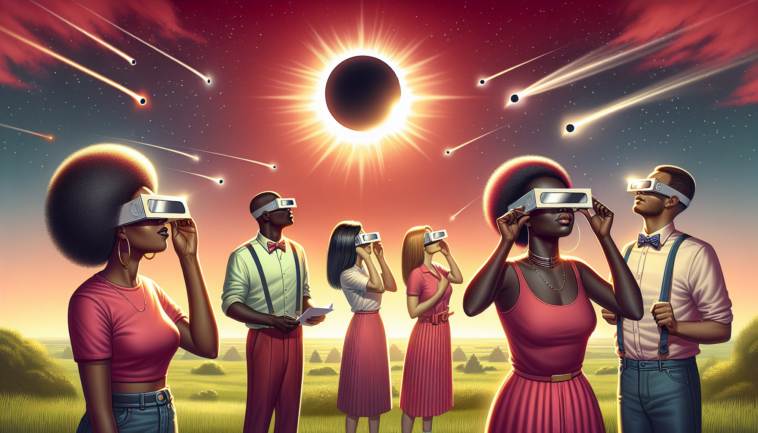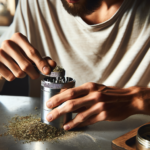Without the right precautions, such as using specialized solar viewing protection, viewers risk severe eye injury by directly observing any part of these solar eclipses. Understanding how to see eclipse without glasses becomes essential, as regular eyewear or unfiltered devices can’t safeguard against the sun’s damaging rays.
With the increasing demand on how to safely view a solar eclipse, this article delves into alternative, safe methods like creating pinhole projectors or utilizing eclipse glasses that meet the ISO 12312-2:2015 standard. These methods ensure that enthusiasts can enjoy these celestial events without risking eye health, highlighting the importance of proper preparation for such rare occurrences.
Using a Pinhole Projector
A pinhole projector offers a simple, safe, and cost-effective method to view solar eclipses without the need for specialized equipment. Here’s how you can make and use one:
Materials Needed:
- Two pieces of stiff white cardboard or plain white paper
- A pin or thumbtack
Steps to Make a Simple Pinhole Projector:
- Create the Pinhole: Use the pin or thumbtack to make a tiny hole in the center of one piece of cardboard or paper.
- Set Up the Projection: Stand with your back towards the sun. Hold the paper with the pinhole above your shoulder, allowing sunlight to pass through the pinhole.
- View the Eclipse: Place the second piece of cardboard or paper about a meter away from the pinhole paper. This will act as a screen where you will see an inverted image of the sun. To increase the size of the sun’s image, simply move the screen further away from the pinhole paper.
Safety Measures:
- Never look directly at the sun, even during an eclipse, without proper eye protection.
- Always keep your back towards the sun while using the pinhole projector to avoid accidental exposure.
By following these steps, you can safely enjoy the view of a solar eclipse and understand more about this celestial phenomenon, just as institutions like The Franklin Institute do using similar optical techniques.
Viewing with a Cereal Box Viewer
Creating a cereal box viewer is an accessible and safe method to observe a solar eclipse without directly looking at the sun. Here’s a step-by-step guide to making your own viewer:
Materials Needed:
- An empty cereal box
- Aluminum foil
- White paper
- Scissors
- Tape
- A small nail or pin
Instructions:
- Prepare the Viewer:
- Cut two holes on the top sides of the cereal box, leaving the center intact.
- Trace the bottom of the box on a piece of white paper, cut it out, and tape it to the inside bottom of the box.
- Set Up the Projection Screen:
- Cover one of the top holes with a piece of aluminum foil. Secure it with tape and gently poke a small hole in the center of the foil using a nail or pin.
- Using the Viewer:
- With your back towards the sun, place the box over your head like a helmet or hold it up to your eyes, ensuring you look away from the sun.
- Adjust the box angle until the sunlight passes through the pinhole and projects an image of the sun onto the white paper at the bottom of the box.
- Observe the projected image as the eclipse progresses; you will see the phases of the eclipse reflected on the paper.
Safety Tips:
- Always ensure your back is to the sun when looking through the viewer to avoid direct exposure.
- Do not use damaged or torn foil as it may not effectively filter the sunlight.
- Supervise children at all times during the construction and use of the cereal box viewer.
This method not only provides a safe viewing technique but also an educational experience that can be shared with friends and family.
Utilizing Nature’s Pinhole Cameras
Nature offers its own fascinating method to view solar eclipses safely through what is known as “Nature’s Pinhole Cameras.” This method involves using the natural gaps in foliage to create a pinhole effect, which projects images of the eclipsed sun onto the ground or other surfaces.
- Tree Leaves as Pinhole Cameras: As sunlight filters through the gaps in tree leaves, it casts tiny, exact images of the sun on the ground. During an eclipse, these gaps create miniature projections of the eclipse, allowing viewers to track its progress safely.
- Creating Your Natural Viewing Station:
- Materials Needed: Locate a tree with dense foliage or gather a colander and white poster board.
- Setup: Place the white poster board under the tree or hold it beneath the colander. This acts as a screen to catch the projected images.
- Viewing: Look at the poster board, not the sun, to see the eclipse’s progress through the shadows formed.
- Alternative Methods Using Hands: Create a grid with your fingers by overlapping them to form small openings. This can project half a dozen small crescent shapes during the eclipse.
These simple and accessible techniques not only enhance the experience of viewing a solar eclipse but also ensure that it is done safely, leveraging everyday objects and the natural environment
Creating a Box Projector
Creating a box projector is an effective way to view solar eclipses safely. Here’s a step-by-step guide on how to construct this simple device:
Materials Needed:
- A long cardboard box or tube
- Scissors, duct tape
- Aluminum foil
- A pin or a thumbtack
- A sharp knife or paper cutter
- A sheet of white paper
Instructions:
- Prepare the Box:
- Trace the bottom of the box on a sheet of white paper and cut it out.
- Tape this cut-out inside the bottom of the box to serve as your projection screen.
- Modify the Box:
- Cut two square holes on the opposite end of the box, one on each side.
- Cover one of these holes completely with aluminum foil and secure it with tape.
- Using a pin or thumbtack, carefully punch a small hole in the center of the foil.
- Viewing the Eclipse:
- Stand with your back to the sun so that its light shines into the pinhole.
- Look through the hole you did not cover, and you will see the sun projected onto the white paper inside the box.
- Adjust your position until you see a small projection, a reversed image, of the eclipsed sun on the paper.
This method not only provides a safe viewing experience but also an educational opportunity to understand the mechanics of light and projection.
Wrapping Up
From the simplicity of a pinhole projector or a cereal box viewer to the natural wonder provided by tree leaves acting as nature’s pinhole cameras, each technique has been detailed to ensure that anyone, regardless of resources, can enjoy the rare spectacle of an eclipse without risking eye health. Moreover, the creation of a box projector further exemplifies how everyday materials can be transformed into a tool for scientific observation, providing a hands-on learning experience about the principles of light and projection.
The significance of these methods lies not only in their educational value but also in their ability to foster a safer approach to experiencing one of nature’s most awe-inspiring events. By embracing these safe viewing practices, individuals can partake in the communal excitement surrounding solar eclipses while preserving their sight. As we look forward to future celestial events, let this guide serve as a resource for preparation and inspiration, encouraging further exploration and appreciation of the cosmic phenomena that connect us all.
FAQs
You can use a colander to safely observe an eclipse. Simply hold the colander about 20 inches above the ground, with your back facing the sun. This method is recommended by the Exploratorium and allows you to view the eclipse indirectly.
It is not safe to look directly at an eclipse without protective eyewear, even during a total eclipse. Although you might not feel immediate pain, the sun’s rays can still cause significant damage to your eyes, which might not be noticeable right away.
To view an eclipse using your hands, hold your palms up with one hand over the other at a 90-degree angle. Slightly separate your fingers to create a waffle pattern, allowing the sunlight to pass through and project an image of the eclipsed sun onto the ground or another surface.
Regular sunglasses, even those offering 100% UV or UV400 protection, are not sufficient for safely watching an eclipse. These sunglasses are designed to protect against UV rays but do not offer the necessary protection against the intense light of an eclipse.



GIPHY App Key not set. Please check settings